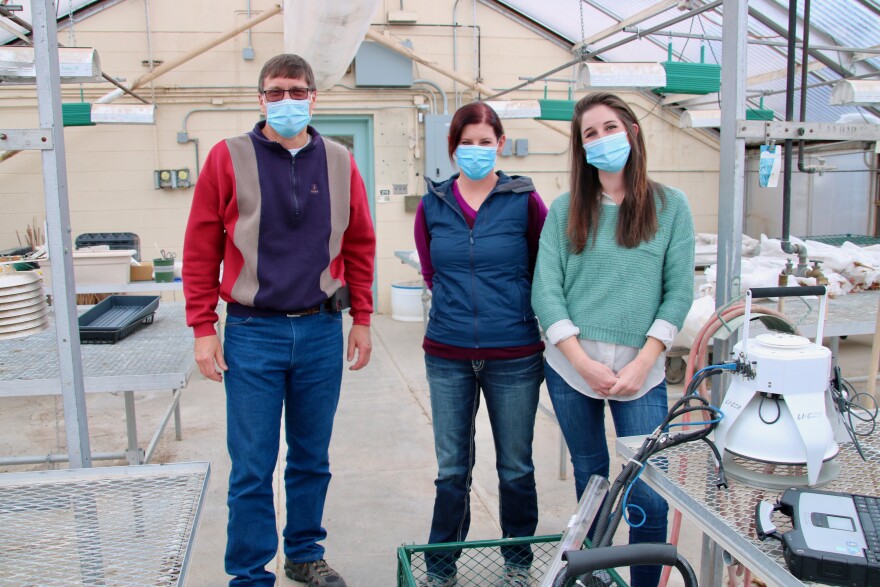The U.S. dairy industry has set an ambitious goal to reach greenhouse gas neutrality by 2050, and some Idaho scientists are part of a research project that will inform how the industry can reach that goal.
The greenhouse gasses that contribute most to rising temperatures are carbon dioxide, methane and nitrous oxide.
They’re all found naturally in soil. But depending on its qualities, soil can either act as a source of these gasses, releasing them into the air, or as a sink, holding onto them to prevent atmospheric warming.
So, the soil and crops grown in it are an important part of a dairy farm’s environmental profile.
“The feed production and the milk production — the dairies themselves — are the biggest pieces of the carbon footprint of the whole dairy production chain," said April Leytem, a soil scientist at the U.S. Department of Agriculture research center in Kimberly, outside of Twin Falls.
Leytem was tapped last year to lead a site on a national research project looking at how the dairy industry can improve soil health.
“To see what kind of gains they could get in offsetting carbon to help them get to net zero," she said.
Producing crops like corn and alfalfa for cows makes up more than a quarter of a dairy farm’s carbon footprint.
Last year, the dairy industry, including the Foundation for Food and Agriculture Research, dedicated $23 million to support this six-year research project. The goal is to build soil health to reduce greenhouse gasses, improve water quality and open up new economic benefits for farmers who are reducing soil emissions.
"A lot of the solutions and practices and technologies are available for farms today, but we're working as an industry to address the affordability, the accessibility to those solutions and closing some of the data and research gaps," said Karen Scanlon, the executive vice president of environmental stewardship for Dairy Management, Inc. and the Innovation Center for U.S. Dairy.

The eight research sites are in major milk-producing states like California, Wisconsin, New York and Idaho — all of which have different climates and soil profiles.
“It’s a big dairy state, but we’re also in a very arid region," said Leytem, "and so all of our cropping systems are irrigated and you don’t have that in Wisconsin and New York.”
Idaho’s weather varies — it gets quite hot in the summer and snow covers the ground in winter, which on this day, forced another researcher on the team, Abigail Baxter, to work in the greenhouse.
“We have these little set-sized collars that we put into the soil and then that sits right on top of it,” she said, pointing to the “brains of the operation,” a white soil gas chamber that looks like an upside down mixing bowl with a handle.
Baxter takes it around the farm fields at the Kimberly research site to measure gas emissions.
“This little wagon set-up is how I cart it around the field, literally," she said. It takes her four to five hours to hit all 24 plots.
Each plot has been treated differently — some have been fertilized with cow manure; some haven’t. Others have been fed new manure products the dairy industry is testing out that look like dirt pellets.

“When you go to take a measurement, this part of the chamber closes and then it kind of stabilizes that environment in the system and mixes up the gasses," Baxter said. "The air that’s trapped in there and then it vents it through these two analyzers to get a measurement of the different gasses.”
When the six-year study is done, scientists hope to have a better understanding of the greenhouse gas footprint of growing crops for dairies and the best soil management practices to reduce emissions.
They’ll share the research with farmers, and will also use it to back up the development of new carbon markets.
“Farms are wondering, you know, 'could I potentially participate in one of these markets by sequestering carbon or adopting new technology to prove that I can reduce the footprint?'” said Jamie Vander Molen who works at Newtrient, a company that helps dairy farms find economically-viable environmental solutions.
The industry emphasizes that farmers need financial incentives to make these moves.
Some environmental groups agree that voluntary action could yield better results than regulation in a place like Idaho when it comes to on-farm soil management practices.
“Not adopting some of these sustainable practices isn’t a lack of desire, honestly, it’s just not economically feasible for them to do so,” said Aly Bean, a climate coordinator with the Idaho Conservation League.
She said ICL is looking into how the Idaho Legislature could incentivize beneficial soil health practices like planting cover crops, perhaps by dedicating funds to local soil and water conservation districts.

Bean also said reducing greenhouse gasses is very important, but so is adapting to the climate effects that are happening now.
“There's also the other piece of the story of climate change is happening and it’s actually really hurting the dairy industry,” she said.
A climate assessment report released late last year by the University of Idaho found heat stress from rising temperatures could lead cows to produce less milk. And droughts hurt yields of hay and alfalfa, crops commonly grown for dairies.
Josh Johnson, a conservation associate at ICL, said, going forward, he would like to see a more detailed plan of how dairy will get to greenhouse gas neutrality, as well as more of a focus on addressing how nitrogen and phosphorus in manure affect water quality.
Industry officials say the research happening at places like the USDA site in Kimberly will help develop the pathway to reaching the environmental goals, and they plan to publish the first progress report in 2025.
Find reporter Rachel Cohen on Twitter @racheld_cohen
Copyright 2022 Boise State Public Radio



